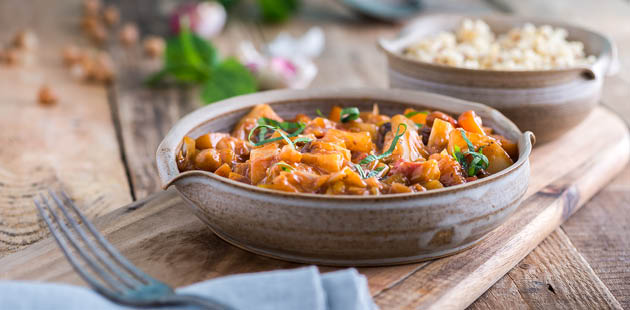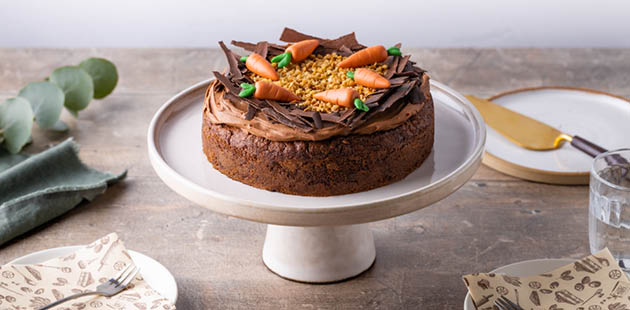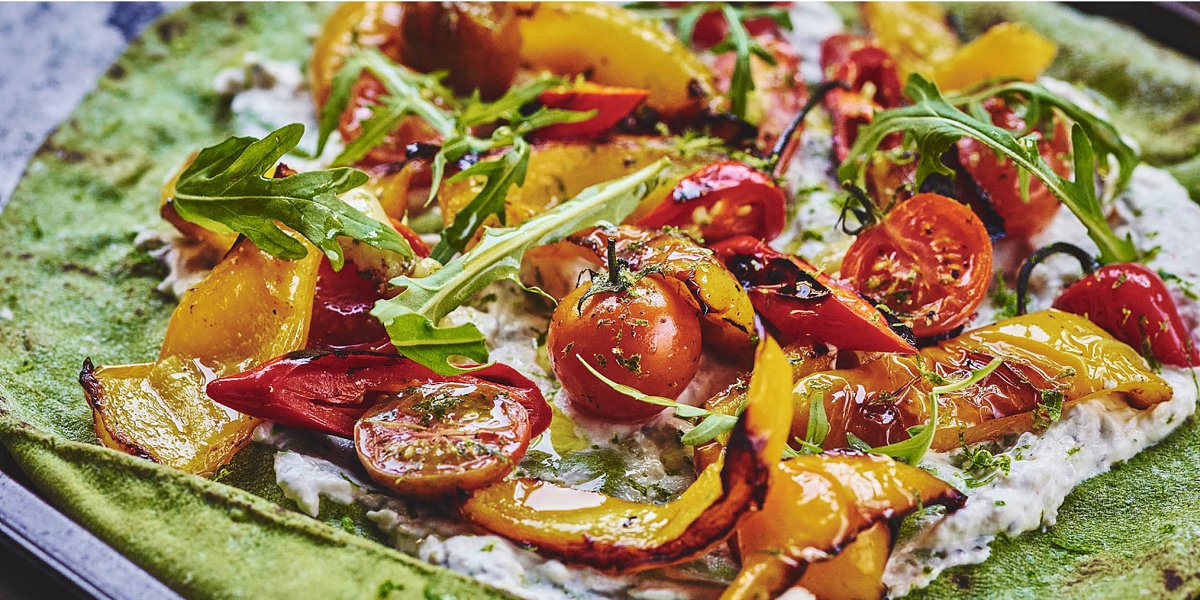Making meat-free menus shine in care
Make your meat-free cooking shine with our guide to all things vegetarian and vegan.

There are few food trends as permanent as the meat-free movement. Vegetarian and vegan diets are anything but a fad, with thousands of people making permanent lifestyle changes with their health and the planet in mind.
Of course, we know food trends in wider society often take longer to find their way into care homes, and while veganism may still make up a low proportion of residents’ diets, plenty are looking for meat alternatives, influenced by intolerances, health conditions, what they read and hear from loved ones.
“There are an estimated 7,000 vegetarians and vegans in residential and nursing care homes, and this is a figure that has more than doubled since 2014,” says Vegetarian for Life roving chef Ollie Bragg. “The numbers are increasing all the time and are set to continue to rise with more people choosing a vegetarian or vegan lifestyle than ever before. This means as people age, some people will inevitably need to reside in care environments and need to be catered for.”
At care provider HC-One, development chef Chris Bonner says they have already had roughly 150 homes sign up to its new Memory Pledge, which it signed with Vegetarian for Life. It asks providers to proactively support residents who once lived a vegetarian or vegan lifestyle, but who may now have cognitive or memory difficulties, to continue to do so.
During spring and summer, the provider’s homes offer a meat-free salad option, while in autumn and winter chefs cook a stew or other warming dish which uses a different protein, such as pulses or beans.
“We have seen that when residents who are vegetarian are sitting at a table with people who would normally eat meat, they are asking for meat too,” Bonner explains. “We have a responsibility to encourage them to try and continue those life choices. It’s important to residents, and it can be very upsetting for residents’ families and friends.”
It is an issue care chefs will need to get to grips with before younger generations, where veganism and vegetarianism is often more common, begin to enter social care. “Kitchens in care homes are increasingly having to provide vegetarian options, and occasionally, vegan options for residents,” James De Jong, development chef at Creed Foodservice, says. “While in comparison to the high street evolution of preferences seems slow, we’re expecting to see a jump in demand for plant-based options as the next generation – the Baby Boomers – reach an age where care may be needed. This generation shows a strong interest in food, with a survey commissioned by Creed Foodservice suggesting that 80% of this age group would pay a premium for better quality food and hospitality in care homes.”
Where to begin
The importance of meat-free meals is clear. But in busy kitchens, vegetarian dishes can sometimes receive less thought than traditional meat choices. So if you’re keen to start putting plant-based options in the spotlight, where should you begin? Roving chef at Vegetarian for Life Justina Bajorinate says it is much easier than you might think.
“Nowadays there are multiple meat and dairy replacements,” she explains. “Just be mindful that the dish served is well balanced and nutritious. Instead of just removing parts of the dish to suit the diet, think about how to replace them, making sure that the meal contains a good source of protein. It is useful to evaluate the dish by thinking ‘would you be happy to eat it if someone served you this? Would it be enjoyable, filling and nutritious’?”
De Jong advises chefs to do their research. “Specialist cookery books which focus on these types of dishes may provide inspiration, and often recipes can be adapted to increase their nutritional value, making them entirely suitable for a care setting as well as for those cooking at home,” he says.
Consider why a resident is vegetarian or vegan – is it down to taste preferences, religious beliefs or environmental concerns, perhaps? Understanding their rationale means chefs will be better-placed to choose dishes which suit them. Residents who simply don’t enjoy the taste of meat may be less keen on meat replica products and instead would prefer dishes where vegetables shine.
It’s also crucial to consider how to make vegetarian and vegans feel included at mealtimes. This is where meat substations, such as plant-based mince, may be helpful, De Jong says.
“Using products like firm tofu scrambled as a replacement for eggs in the morning means vegan residents are still getting vital protein, without the need for animal-based products being used,” he adds.
For chefs looking for inspiration, Rational UK has put together a selection of vegan recipes that are available to download for free via the company’s Connected Cooking app, and are designed for use with its iCombi Pro combi steamer and iVario multifunctional cooking system. “The demand for vegan food was always going to grow,” says Ross Crook, its regional development chef. “However, the pandemic has given it an even bigger push, by focusing peoples’ minds on issues such as healthy diets and the environment – and vegan food ticks both boxes.”

A dish created using a Mars sauce
Broad appeal
Aiming your dishes at all residents, not just vegetarians, can expose them to new flavours, streamline your processes and encourage creativity in the menu design. Gordon Lauder, managing director at Central Foods, agrees, suggesting a tempura vegetable mix or flatbreads, which can be loaded with different toppings, as options.
“The proportion of care home residents who are vegetarian and vegan is still quite small but the trend for vegetarian and vegan food has been increasing for some time now and all research seems to suggest that the trend is only going one way… And that’s up,” he says.
“There’s a big appetite currently for small plates, bite-sized menu items and sharing platters and Central Foods offers a range of easy-to-serve tasty tapas options to suit this trend. Many are plant-based so they’re ideal for residents with dietary requirements. They’re so good that they’re sure to go down well with all your residents, not just those who are looking for meat and dairy-free options.”
He says a tapas style of dining gives residents choice over how much they eat, encourages them to try different dishes and encourages a sociable way of eating.
At the end of the day, if a dish is well thought out, balanced and delicious, there is no reason it won’t have a wider appeal. “Flavoursome and attractive plant-based options are likely to go down well with all residents, not just vegans and vegetarians, given the increasing interest in a flexitarian diet,” agrees Marie-Emmanuelle Chessé, international development project manager at Tipiak. “This was the inspiration for our recently launched ‘thaw and serve’ vegan cocktail selection – a range that not only appeals to those on a plant-based diet but all diners. It features some amazing plant-based flavour combinations that work well with drinks as well as being simply delicious in their own right on any afternoon tea, buffet, event or party menu.”
A balancing act
However much you focus on making your meat-free meals sing, there will always be residents who opt for a traditional meat dish. Brett Wainwright, business unit controller – foodservice, at Quorn Foods, says while there is demand for more vegetarian options, it is key to continue offering choice. “This means that a completely meat-free menu or certain meat-free days aren’t always effective,” he says. “Instead, we would suggest always having a meat-free alternative to traditionally meat-based favourites, and promoting these around key events such as Veganuary, highlighting the point of difference.”
He says chefs don’t need to serve a dish in both meat-free and meat-based options – use alternatives such as its no-beef pieces, sausages and fillets to adapt recipes, such as a no-beef pie or cobbler or Massaman curry, and serve them alongside a different meat dish.
To save your team time, making use of the vast array of products and alternatives now on the market will help – add pulses, beans or chickpeas and fresh herbs into a ready-made sauce and serve with rice or salad for a nutritious meal.
Alison Smith, global product developer at Mars Foodservice, agrees that caterers should offer a minimum of one plant-based option at each meal, but says: “Still, for many care home caterers, the prospect of creating nourishing plant-based dishes - alongside meat dishes – can be daunting, particularly given the time constraints and demands of busy care homes. This is where a high-quality range of plant-based ready-to-use sauces such as those from the Dolmio Professional and Ben’s Original Professional foodservice range can make a real difference.”
Ultimately, few sections of the food world are evolving as quickly as vegetarianism and veganism, agrees Anna Sentance, gourmet marketing manager at Callebaut UK and Ireland.
“This makes having inclusive options on menus a vital consideration for caterers to meet their residents’ needs, especially in the care home setting, where all dietary requirements will need to be met,” she says.
“With 15% of consumers saying they would be more likely to order a dessert if it was vegan, proving that by adding simple, inclusive options to their menu, chefs can cater to a wider audience. With every chef’s ability in mind, Callebaut’s recipes provide operators with simple ways to transform traditionally loved chocolate dishes to delicious inclusive options.”
There have never been more resources and products available to help you provide first class meat-free meals. In a growth area which is showing no signs of slowing, now is the time to make sure you are going above and beyond.

Recipe: Vegan chocolate chip carrot cake
Callebaut has provided a plant-based sweet treat for you to try. It serves eight, and has a prep and cook time of 30 minutes each.
Ingredients
150g plain flour
25g ground almonds
10g baking powder
2g ground cinnamon
75g caster sugar
75g brown sugar
150g grated carrot
2 flax eggs
100g Callebaut 811 dark chocolate callets
120g vegan butter
For the icing
250g vegan cream cheese
Zest of an orange
200ml plant-based cream
100g Callebaut 811 dark chocolate callets
Method
1. Mix the flax powder with water.
2. Add all of the wet ingredients.
3. Add the grated carrot.
4. Mix all the dry ingredients into the mixture.
5. Place into prepared cake tins and cook at 160C in an 18cm cake ring, 4.5cm high, for around 25 to 30 minutes.
6. Leave to cool.
7. To make the icing, place the cream and orange zest into a saucepan and bring to the boil.
8. Add in the chocolate callets and emulsify.
9. Allow to cool to 30C and then fold through the cream cheese.
10. Cover the cooled cake with the icing.








